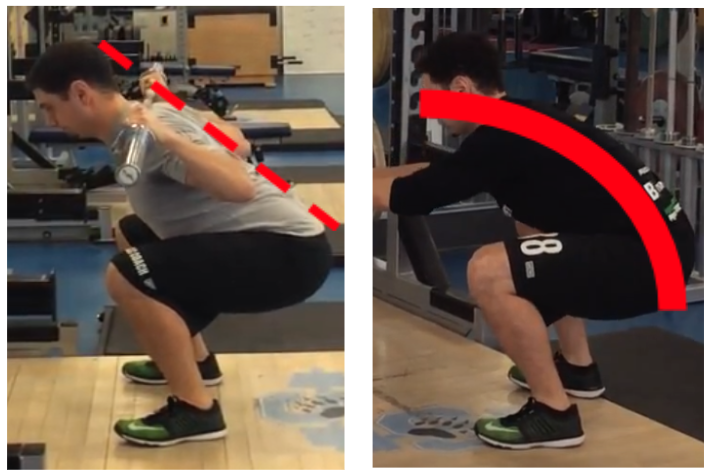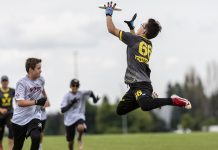Ultimate Canada Magazine – March 3, 2020.
Written by: Colin Young, HSP Assistant Coach
Edited by: Mike Haddock, HSP Head Coach
The following is the first in a 4-part blog series about designing a High Performance Program for Ultimate Athletes. In this series, we will explore critical foundational exercises within Strength, Plyometrics, Agility, and Stability/Accessories, and provide some insight on our programming. Please note, there are risks associated with any exercise and should be considered carefully for any athletic program. Consult individually with a professional as needed.
Why should Strength be developed in the offseason?
Strength (or the expression of force) a critically important quality for almost all athletes. By improving your overall force production, you can set the stage for Power & Speed training and it can decrease the risk of injury by forcing you to build stability and control. In the offseason, athletes have significantly reduced field time, so there is an overall lower demand placed on an athlete’s body and an optimal period of time to incorporate focused resistance training is created.
Key Offseason Strength Building Exercise – The Barbell Back Squat
Some readers may wonder we choose a two-legged (bilateral) exercise over a one-legged (unilateral) exercise – and here is our thought process!
From the outset, it’s important to note that both have a critical role in athlete development. It’s never an ‘either/or’ question, but when and how. In this case, we chose a bilateral exercise over unilateral exercise because:
- When appropriate, it can allow for more external load to be applied, which in turn challenges force production in many joints and muscles.
- It is very time effective! You ‘only’ have to do ‘1 stance per set’, rather than completing each side/stance.
- It can be easier for athletes to learn control early on, as the movement symmetry can make it ‘simpler’ to remember key cues in the moment.
- Remember our key goal is to Develop Strength, which means we are carefully selecting our exercise with that goal in mind.
In comparison, having an athlete begin at a more complex Unilateral exercise (for example, a skater squat), would mean greater requirement on foot balance and torso control before you can even attempt to add weight. Improper foot balance can result in a loss of stability and knee wiggle (or valgus) and is a risk that should be avoided with this or any exercise. Therefore, early in the offseason training, more focus can be placed on bilateral movements before progressing to any number of unilateral movements. Once again, this does not mean that unilateral movements should be neglected – but if an athlete has control issues, we might view them as more Accessory/Stability focused, versus actual Strength development focused.
Benefits
The Barbell (BB) Back Squat allows for great carryover to our field-specific performance, as it challenges the athlete to a powerful extension either forward or upward, as needed on the field. Muscles of the lower body (glutes, hamstrings, and quadriceps, among others) will be stimulated and challenged and the strength developed from this exercise allows for a better base for power, improved speeds, and a reduction in injury risk.
Three Major Risks to the BB Back Squat & Techniques to Minimize Them
First, recognize that an athletes’ squat stance can be different and due to variables, such as bone structure & length, as well as limb proportions; however, all squats have some things to look out for, that when overlooked can have an increased risk for injury.
Risk #1 Spinal Movement (aka ‘Pelvic/Butt Wink’)

Right Picture: Improper Bottom Position – Athlete is showing significant spinal flexion (‘rounding’), and pelvis is tilting/’winking’ under – and not within a neutral range.
In the 99% of loading scenarios, an athlete must focus on and work hard to ensure that the spine and torso musculature create stiffness. The primary focus on the torso should be to resist any movement, in any direction. Over time, being under increased loads and higher degrees of spinal movement can create risk of injury towards the athlete. To eliminate risk for injury, ensure proper bracing mechanics are being used and search for the depth where there is zero movement in the spine, and adjust/control your depth to eliminate it from occurring.
What can you do to Eliminate? Learn how to Brace! Check out our Torso Stability – Bracing & Breathing video, and learn more about the Theory & Techniques.
Risk #2: Loss of Knee Stability
Knee Position is another risk component in the barbell back squat. Ideally, you want the knee cap to be aligned with the 3rd toe. This is a position you should fight to maintain, regardless of foot position and stance because valgus position on the field, especially at high speeds and under load leaves a risk for ACL and MCL, and meniscus injuries.
Improper Knee Positioning: During a loaded exercise, the knees wiggle or shift inwards, causing a risk for knee irritation or injury.
What can you do to Eliminate? Learn to Use your Glutes! The goal is to reduce knee movement; so to start, try to ‘engage’ your glutes by squeezing and externally rotating your femur (thigh bone) outward to allow for better alignment of the knees. Remember that the glutes are huge and powerful muscles that when not used properly can negatively impact the movement, making it harder and riskier. We will come back to the Ankle below!
Check out our Controlling Knee Position (Anti-Valgus Band Squat) video, and learn more about the Theory & Techniques.
Risk #3: Losing “Full Foot” Contact
During our big strength elements, you want the entire foot to be in firm contact with the ground and the weight to be evenly distributed (to the heels and toes) throughout. If an athlete ‘shifts back’ and puts too much pressure on the heel, it could become difficult to balance and could inhibit usage of the quadriceps (a key muscle). Alternatively, if an athlete ‘shifts forward’ and the heels leave the ground, the internal loading will be distributed forward to the toes. If this is done in an extreme manner, it can place a lot of unnecessary stress on the anterior knee structures and more importantly, lose the posterior-chain contribution of the glutes.
Improper Foot Contact: During a loaded exercise, athletes should always maintain a ‘tripod’ foot in which weight and pressure are evenly distributed among heel, big toe and pink toe.
What can you do to Eliminate? Learn to Grip the Ground! If you aren’t already, focus on achieving a tripod foot, with feet rooted into the ground and emphasis on the heel, big toe, and pinky toe.
Check out our Intro to Tripod Foot & Single Leg Balance video, and learn more about the Theory & Techniques.
As you can see, the benefits you can reap from strength training greatly outweigh the risks. You can get stronger, build a better foundation for future performance, and work on some key injury prevention components. By striving to achieve perfect technique, you can minimize risk and maximize return for the offseason. When done correctly, you will enter the season stronger and better than ever before!
Mike Haddock is the owner of Haddock Sport Performance (HSP), and has been the head Strength & Conditioning Coach for Ultimate Canada. If you would like to learn more about HSP tips, technique, and work; follow Mike Haddock and Colin Young on Instagram!







